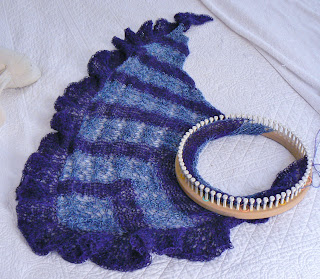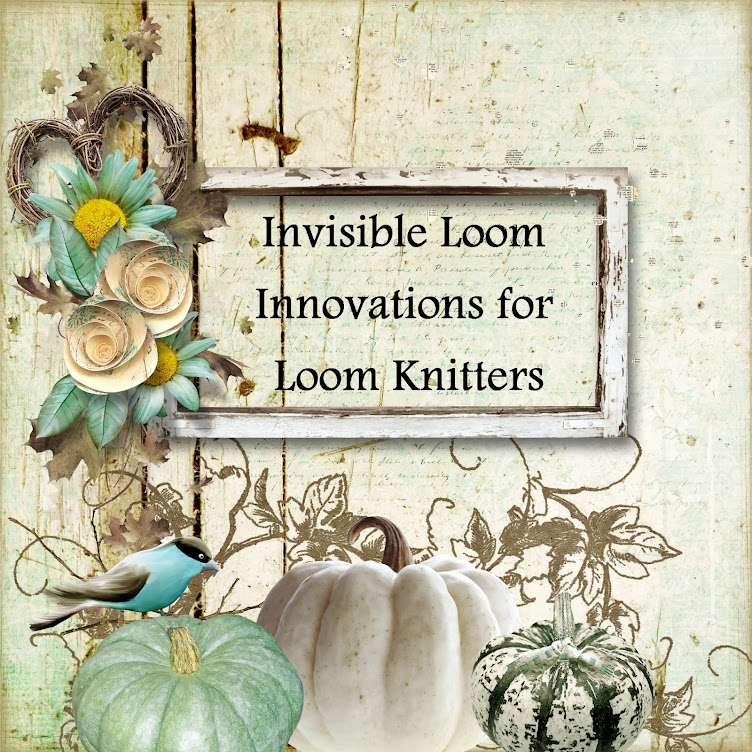You may not know it, but putting a spine into a loom knit shawl is not so easy. In a needle knit pattern, the spine down the center of a triangular shawl is created by working yarn-overs as the shawl is knit from the center, outward. There are two general needle knit shawl structures; one starts from the top center of the shawl, with just a few stitches. Stitches are "picked up" along the edges of a small section of garter stitch, and the shawl is worked outward, increasing both sides at once, until the bottom edge is reached. Try this on a loom....

The second needle knit shawl style starts at the bottom, with hundreds of stitches cast on, and the shawl created by working with an ever decreasing amount of stitches towards the center. Neither is a practical way of making a shawl on a loom, and you can tell this because there is not a pattern for the loom that makes a "top down" or "bottom up" shawl. I tried to worked out shawl patterns that created the same look, by using the short rows to create the appearance of a center spine. In the first two photos, Peaceful Day Shawl and Sweet on Ruffles Shawlette , you see the center spine created by the short rows, with both the shawls made on a hat loom using less than 66 pegs.
In the third photo, the aqua shawl, the necessity of balancing the two different yarns and the color changes led to a different spine. In the Travel By Rail Shawl, color changes create a striped spine, that defines the center of the shawl, without the appearance of yarn overs.
In the fourth photo, the "Steamer Shawl" has an eyelet stripe down the center. This is a much larger, defined spine. For this shawl, I had planned to have the spine match the eyelet rows on either side, and have ribbons run through all of the eyelets. In the end, I left the ribbons out of the center.
The next photo shows a spine with an entirely different purpose. For the American Paris Shawl, the spine is off center, and needed to both define a new section of the shawl, as well as coordinate with the eyelet sections of the stitching. A single row of eyelets was worked at a color change point to create this appearance.

The last photo, of a shawl still on the loom, shows the evolution to no spine at all. When blocked, this will be an seamless heart shaped lace shawl. Although it is worked in 4 distinct sections, it has the appearance of a full sized, one piece shawl. It is made on 58 pegs of a hat loom. So, the question remains for me, now that we loomers have looms with large numbers of pegs readily available, is it still important to worry about spines and shawls made within the confines of a hat loom? I think the answer is yes. It will not be practical to work on a 400 peg loom and manipulate hundreds of stitches for decrease/increase rows (within the row of stitches.) Short rows are a fabulous, easy solution for loom knitters to create shapes, in any stitch pattern, on a small number of pegs. And we have all the spines a needle knitter could ever want.
Loom Knit Shawls: From Simple to Sublime ebook $12.00 US  Copyright 2012 by Invisible Loom, Renee Van Hoy. All Rights Reserved.
Copyright 2012 by Invisible Loom, Renee Van Hoy. All Rights Reserved.
It has been a long time since we've had tea on Tuesday, so I hope you will enjoy a nice cup of summer tea and this recipe.
Apricot Coriander White Chocolate Scones
Elegant and indulgent, these are the perfect scones to pamper your family and friends with. Be sure to use good quality dried apricots and white chocolate chips. These scones especially good warm, so you may want to make them ahead just up to the point of baking, and freeze the unbaked scones on the baking sheets wrapped well in plastic. The day of your tea party, remove the scones from the freezer, unwrap, and place them right
in the oven to bake. This recipe makes 12 larger scones, or you can cut them smaller for more servings.
2 cups flour
2 tsp. baking powder
1/2 tsp. salt
2 TBSP.(vanilla) sugar
1/2 tsp. ground coriander
1/3 cup unsalted butter, chilled and cut into small pieces
1/2 cup dried apricots, diced
1/2 cup white chocolate chips
1/2 cup milk (2 % OK)
1 large egg
Pre-heat the oven to 375 degrees. Line a large baking sheet with a silicon baking mat or parchment paper. In a large bowl, whisk together the flour, baking powder, salt, sugar,
and coriander. Cut in the butter with a pastry blender or two knives, until the flour takes on the texture of course meal. Toss in the apricots and white chocolate chips. Make sure the apricot pieces are separated and coated with the flour so they do not clump together.
In a separate bowl, beat together the milk and egg. Add to the dry mixture and stir with a fork until a soft dough begins to form. Knead lightly to incorporate all of the flour. Divide the dough into two balls and form into 2 six inch rounds. Cut each round into 6 triangles, OR pat the dough into a rectangle and cut diagonally for smaller scones. Separate the scones slightly and place them on the baking sheet. The sides should not be touching. Bake for 15 minutes at 375 degrees. Cool on a rack. Eat one warm, you’ve earned a treat!
Copyright by Renee Van Hoy, Invisible Loom 2001, 2012. All Rights Reserved.
Lots of different projects over the past month for my looms. The first photo shows a Wingspan made for the Loom Class group. (One more week, you can still join us.) This Wingspan was made on the new AKB all-in-one loom, from 1 skein of Mini Mochi fingering yarn in Neptune. Love the pegs on the loom, and the fabric, but the smaller gauge made a very small Wingspan. A better choice would be the Martha Stewart loom using small pegs, with a far greater number of pegs. The AKB will be a great loom for smaller projects, and I'm hoping they will add the option of additional side extension pieces to increase the number of pegs.
The second photo shows a round baby blanket made for the Ravelry loom-a-long, going on through May. This was made from Cottontots yarn in Sweet Cream, with the crochet ruffle edging done in Dollhouse. I used the Provocraft ergonomic crochet hook for the edging, and found it a great improvement, even over my usual padded hooks.
The last photo shows some modular samples I am working on, possibly for a new collection of patterns. The little facecloths look like 4 mitered squares, but they are actually made all in a single piece, with no decreasing or increasing, no moving the loops. What's on your loom?
Blooming Loom: Colorful Patterns for Loom Knitters ebook $12.00 US  Loom Knit Shawls: From Simple to Sublime ebook $12.00 US
Loom Knit Shawls: From Simple to Sublime ebook $12.00 US 





